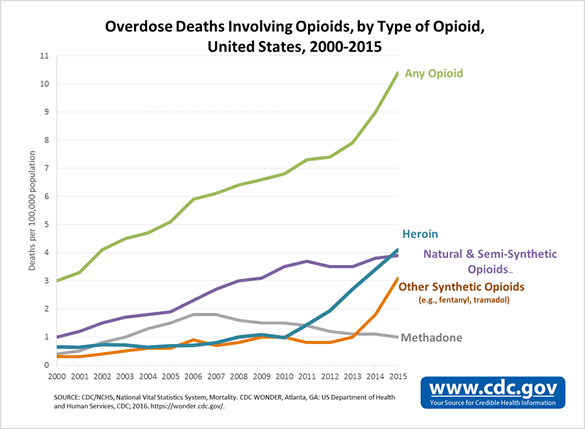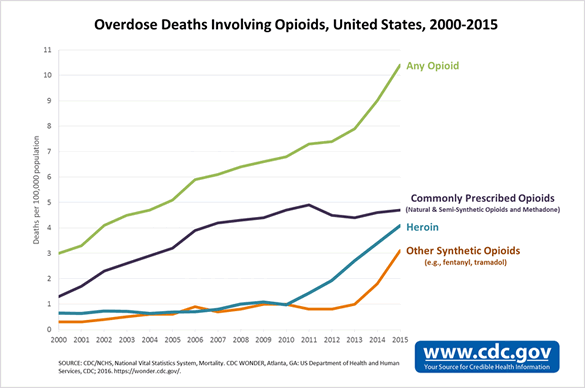Opioid Data Analysis
Categories of opioids
Prescription Opioids
Opioid analgesics (commonly referred to as prescription opioids) have been used to treat moderate to severe pain in some patients. Natural opioids, semi-synthetic opioids, methadone (a synthetic opioid), and some other synthetic opioids are commonly available by prescription.
Fentanyl
Fentanyl is a synthetic opioid that is legally made as a pharmaceutical drug to treat pain, or illegally made as a non-prescription drug and is increasingly used to intensify the effects (or “high”) of other drugs, such as heroin.
CDC looks at four categories of opioids:
- Natural opioid analgesics, including morphine and codeine, and semi-synthetic opioid analgesics, including drugs such as oxycodone, hydrocodone, hydromorphone, and oxymorphone;
- Methadone, a synthetic opioid;
- Synthetic opioid analgesics other than methadone, including drugs such as tramadol and fentanyl; and
- Heroin, an illicit (illegally-made) opioid synthesized from morphine that can be a white or brown powder, or a black sticky substance.
How the data are calculated
CDC’s standard analysis approach has combined the natural, semi-synthetic, and synthetic opioid categories (including methadone) when reporting deaths involving opioid analgesics, also referred to as prescription opioids. Using this method, in 2015 there were over 22,000 deaths involving prescription opioids, equivalent to about 62 deaths per day. This is an increase from approximately 19,000 in 2014.1 A significant portion of the increase in deaths was due to deaths involving synthetic opioids other than methadone, which includes fentanyl. Law enforcement agencies have reported recent increases in seizures of illegally-made (non-pharmaceutical) fentanyl.2 It is presumed that a large proportion of the increase in deaths is due to illegally-made fentanyl.1 Unfortunately, information reported about overdose deaths does not distinguish pharmaceutical fentanyl from illegally-made fentanyl.
Given the recent surge in illegally-made fentanyl, the CDC Injury Center is analyzing synthetic opioids (other than methadone) separately from other prescription opioids. This new analysis can provide a more detailed understanding of the increase in different categories of opioid deaths from previous years. Using this analysis, in 2015 there were more than 15,000 deaths involving this more limited category of prescription opioids (an increase in this category of 443 since 2014), equivalent to about 42 deaths per day.3 Changing the way deaths are analyzed seems to result in a decrease in deaths involving prescription opioids. But, this new number is likely an undercount of deaths related to prescription opioids, because it does not include deaths that are associated with pharmaceutical fentanyl, tramadol, and other synthetic opioids that are used as pain relievers.
What this means
Drug overdose deaths can be hard to categorize
In approximately 1 in 5 drug overdose deaths, no specific drug is listed on the death certificate. In many deaths, multiple drugs are present, and it is difficult to identify which drug or drugs caused the death (for example, heroin or a prescription opioid, when both are present).3
Regardless of the analysis strategy used, prescription opioids continue to be involved in more overdose deaths than any other drug, and all the numbers are likely to underestimate the true burden given the large proportion of overdose deaths where the type of drug is not listed on the death certificate. The findings show that two distinct but interconnected trends are driving America’s opioid overdose epidemic: a 15-year increase in deaths from prescription opioid overdoses, and a recent surge in illicit opioid overdoses driven mainly by heroin and illegally-made fentanyl. Both of these trends continued in 2015.3
References
- CDC. Wide-ranging online data for epidemiologic research (WONDER). Atlanta, GA: CDC, National Center for Health Statistics; 2016. Available at http://wonder.cdc.gov.
- Centers for Disease Control and Prevention. CDC Health Advisory: Increases in Fentanyl Drug Confiscations and Fentanyl-related Overdose Fatalities. HAN Health Advisory. October 26, 2015. http://emergency.cdc.gov/han/han00384.asp
- Rudd RA, Seth P, David F, Scholl L. Increases in Drug and Opioid-Involved Overdose Deaths — United States, 2010–2015. MMWR Morb Mortal Wkly Rep. ePub: 16 December 2016. DOI: http://dx.doi.org/10.15585/mmwr.mm6550e1.
- Page last reviewed: February 9, 2017
- Page last updated: February 9, 2017
- Content source:
- Centers for Disease Control and Prevention,
- National Center for Injury Prevention and Control,
- Division of Unintentional Injury Prevention


 ShareCompartir
ShareCompartir


